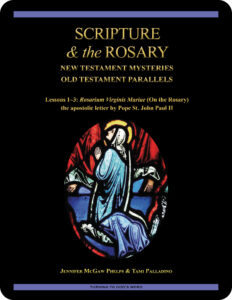 Scripture & the Rosary:
Scripture & the Rosary:
New Testament Mysteries,
Old Testament Parallels
Rosarium Virginis Mariae
Lesson 1 Contemplating Christ with Mary
Rosarium Virginis Mariae (introduction and chapter 1)
Revised Standard Version Catholic Edition (RSVCE)*
New American Bible Revised Edition (NABRE)*
Catechism of the Catholic Church
Rosarium Virginis Mariae (Rosary of the Virgin Mary)
ex libris (in our library)
Aperuit Illis (Instituting the Sunday of the Word of God)
cross references for Scripture & the Rosary
glossary for Scripture & the Rosary
Tami Palladino’s visual-meditation journal
next lesson: The Rosary: A Compendium of the Gospel
This material coordinates with Lesson 1 on pages 6–7 in Scripture & the Rosary: New Testament Mysteries, Old Testament Parallels.
And Mary said, “My soul magnifies the Lord, and my spirit rejoices in God my Savior,
for he has regarded the low estate of his handmaiden.
For behold, henceforth all generations will call me blessed;
for he who is mighty has done great things for me, and holy is his name.”
—the Gospel According to Luke 1:46–49
welcome to our in-depth study of Scripture & the Rosary
We invite groups and individuals to become acquainted with Turning to God’s Word Catholic Bible  studies through
studies through  Scripture & the Rosary: New Testament Mysteries, Old Testament Parallels, which has been granted an imprimatur. Although no longer available in print, the first six lessons can be downloaded from our website. The remaining 20 lessons are posted throughout the liturgical year along with their related online study pages. Click here to access Lesson 1 through Lesson 3. If you have a Bible-related question or comment, you can contact our authors using one of the “ask us your question” or “what do you think” buttons on any online study page.
Scripture & the Rosary: New Testament Mysteries, Old Testament Parallels, which has been granted an imprimatur. Although no longer available in print, the first six lessons can be downloaded from our website. The remaining 20 lessons are posted throughout the liturgical year along with their related online study pages. Click here to access Lesson 1 through Lesson 3. If you have a Bible-related question or comment, you can contact our authors using one of the “ask us your question” or “what do you think” buttons on any online study page.
what to expect from this Bible study
Scripture & the Rosary: New Testament Mysteries, Old Testament Parallels is an unusual Bible study because it focuses on the scriptural underpinnings of the Rosary. It’s intended as a crossover study—designed to help people already devoted to the Rosary learn more about the biblical basis for the Mysteries and at the same time help people already devoted to Bible study learn more about how the Mysteries of the Rosary are tied to the Scriptures. The goal in both cases is to enable participants to be more open to personal encounter with Jesus Christ through increased understanding of the connection between prayer and the Word of God.
every Turning to God’s Word Bible study carries an imprimatur
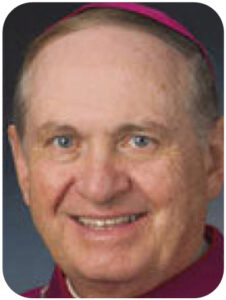 Scripture & the Rosary: New Testament Mysteries, Old Testament Parallels was granted an imprimatur by
Scripture & the Rosary: New Testament Mysteries, Old Testament Parallels was granted an imprimatur by  the Most Reverend Richard E. Pates, (left), bishop emeritus of the Diocese of Des Moines, on August 28, 2012; the censor librorum for the Diocese of Des Moines, the Very Reverend Aquinas Nichols, granted the nihil obstat. These are official declarations that a book or pamphlet is free of
the Most Reverend Richard E. Pates, (left), bishop emeritus of the Diocese of Des Moines, on August 28, 2012; the censor librorum for the Diocese of Des Moines, the Very Reverend Aquinas Nichols, granted the nihil obstat. These are official declarations that a book or pamphlet is free of  doctrinal or moral error. There’s no implication that those who’ve granted the imprimatur or nihil obstat agree with the contents, opinions, or statements expressed in the work. All Turning to God’s Word Catholic Bible studies are submitted to the Church before publication. Visit the archives of Lost in Translation to read more about the Latin terms imprimatur & nihil obstat. Turning to God’s Word Catholic Bible studies written after 2020 are being submitted to the Most Reverend William M. Joensen, Ph.D. (right), bishop of the Diocese of Des Moines.
doctrinal or moral error. There’s no implication that those who’ve granted the imprimatur or nihil obstat agree with the contents, opinions, or statements expressed in the work. All Turning to God’s Word Catholic Bible studies are submitted to the Church before publication. Visit the archives of Lost in Translation to read more about the Latin terms imprimatur & nihil obstat. Turning to God’s Word Catholic Bible studies written after 2020 are being submitted to the Most Reverend William M. Joensen, Ph.D. (right), bishop of the Diocese of Des Moines.
the popes inspire us—serious Catholics study the Word of God
In his apostolic letter Aperuit Illis (Instituting the Sunday of the Word of God) issued motu proprio (of his  own accord), Pope Francis established the Third Sunday in Ordinary Time to be devoted to the celebration, study, and dissemination of the Word of God. The Holy Father’s apostolic letter was published on September 30, 2019, the feast of St. Jerome and the 1600th anniversary of the saint’s death. St. Jerome, who translated the Latin
own accord), Pope Francis established the Third Sunday in Ordinary Time to be devoted to the celebration, study, and dissemination of the Word of God. The Holy Father’s apostolic letter was published on September 30, 2019, the feast of St. Jerome and the 1600th anniversary of the saint’s death. St. Jerome, who translated the Latin 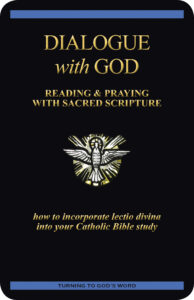 Vulgate Bible from Greek and Hebrew manuscripts, is famous for saying: “Ignorance of Scripture is ignorance of Christ.” In Aperuit Illis, the Holy Father calls attention to the sacramental nature of the Word of God, pointing to the unbreakable bond between Sacred Scripture and the Eucharist. In 2025, the Church will celebrate the Word of God on Sunday, January 26. We’ve posted a free digital version of Dialogue with God: Reading & Praying with Sacred Scripture, our guide to incorporating the Church’s traditional practice of lectio divina (sacred reading) into regular Bible study.
Vulgate Bible from Greek and Hebrew manuscripts, is famous for saying: “Ignorance of Scripture is ignorance of Christ.” In Aperuit Illis, the Holy Father calls attention to the sacramental nature of the Word of God, pointing to the unbreakable bond between Sacred Scripture and the Eucharist. In 2025, the Church will celebrate the Word of God on Sunday, January 26. We’ve posted a free digital version of Dialogue with God: Reading & Praying with Sacred Scripture, our guide to incorporating the Church’s traditional practice of lectio divina (sacred reading) into regular Bible study.
ex libris—read more Church documents
Find links to magisterial documents referred to in Turning to God’s Word Catholic Bible  studies, including Aperuit Illis (Instituting the Sunday of the Word of God), at ex libris—magisterial documents. The page lists significant recent encyclicals as well as a number of historical Church documents.
studies, including Aperuit Illis (Instituting the Sunday of the Word of God), at ex libris—magisterial documents. The page lists significant recent encyclicals as well as a number of historical Church documents.
a few reminders about Turning to God’s Word Bible studies
The most distinguishing feature of our Bible studies is that they’re Catholic. Each one has been granted an imprimatur, which means that a bishop has read the work and found nothing contrary to Church teaching on morals or faith. Note that the imprimatur makes no claim that a work is equivalent to Church teaching, simply that it isn’t opposed to what the Church teaches. Practically speaking, this means that you don’t have to accept Turning to God’s Word interpretations of Scripture, only that choosing to do so doesn’t amount to heresy. Choosing not to accept conclusions of a work that’s been granted an imprimatur doesn’t immediately plunge you into heretical territory, but choosing not to accept Church teaching related to those conclusions does.
read the Catechism—how to avoid heresy
The imprimatur reinforces and validates the claim that Turning to God’s Word Bible studies are Catholic. All participants have a right to expect that discussions about our Bible studies will focus on Catholic teaching. That doesn’t mean that someone won’t occasionally have a question about Church teaching. Not knowing what the Church teaches about a particular issue isn’t heretical. Asking a question about Church teaching isn’t heretical. Failing to understand Church teaching isn’t heretical. Insisting that Church teaching is wrong is.
 Most people who begin to study the Bible are caught off guard by how many challenging theological ideas are found in Scripture. There are a surprising number of things many Catholics believe to be Church teaching that actually are not. In this study, we attempt to present Scripture and Church teaching related to the Rosary Mysteries as unambiguously as possible. When in doubt, you can refer to the Catechism of the Catholic Church or talk with your parish priest about any doctrine that remains unclear.
Most people who begin to study the Bible are caught off guard by how many challenging theological ideas are found in Scripture. There are a surprising number of things many Catholics believe to be Church teaching that actually are not. In this study, we attempt to present Scripture and Church teaching related to the Rosary Mysteries as unambiguously as possible. When in doubt, you can refer to the Catechism of the Catholic Church or talk with your parish priest about any doctrine that remains unclear.
If a Church teaching seems particularly unsettling even after studying the Catechism and speaking with someone who’s knowledgeable regarding Catholic doctrine, you might want to examine whether there might be a personal or emotional reason why you’re having difficulty. Pray for God’s guidance and be open to receiving a different answer than you anticipated, possibly at a later time than you expected or hoped.
be respectful of the others in your group
Keep in mind that most people in your discussion group are there for a Catholic interpretation of Scripture. People from other faith backgrounds are welcome, but the focus of any Turning to God’s Word study always is going to be Catholic in nature. The following opening prayer emphasizes maintaining mutual respect amid differences of opinion:
Heavenly Father, send forth your Spirit to enlighten our minds
and dispose our hearts to accept your truth.
Help us to listen to one another with openness and honesty,
eager to learn from the talents and intuitions that you have given each of us.
Never let differences of opinion diminish our mutual esteem and love.
May we leave this meeting with more knowledge and love for you and your Son.
In the unity of the Holy Spirit, Amen.
You can find other opening prayers on our website. We especially like the following:
Lord Jesus, you promised to send your Holy Spirit to teach us all things.
As we read and study your word today,
allow it to touch our hearts and change our lives. Amen.
WHAT DO YOU THINK about interpreting Scripture?
 The Church encourages Catholics to read and interpret Scripture on our own as long as we follow these two rules:
The Church encourages Catholics to read and interpret Scripture on our own as long as we follow these two rules:
1) Our interpretation can’t contradict anything else in Scripture.
2) Our interpretation can’t contradict Church teaching.
In order to comply, we need to know everything else that’s in the Bible as well as everything that the Church teaches. That’s a tall order, which is why each Turning to God’s Word Catholic Bible study is submitted to the Church for an imprimatur. The imprimatur for Scripture & the Rosary: New Testament Mysteries, Old Testament Parallels is a guarantee that the Church finds nothing objectionable in the work. You’re free to agree with interpretations in this Bible study, but it’s not essential that you do so. There are many different interpretations in other commentaries, but very few of them carry an imprimatur. This doesn’t mean that they necessarily pose any problems in regard to Catholic doctrine or moral teaching, but there’s no Church guarantee that they don’t.
When considering opinions that haven’t been granted an imprimatur, don’t be afraid to ask questions. Our Bible studies address some common interpretations, but there are innumerable opinions floating around about the meaning of different passages in the Bible and those related to the Rosary Mysteries.
 ? Here’s the first question to ask about an opinion expressed in any commentary: How closely does it adhere to what we can read in the biblical text?
? Here’s the first question to ask about an opinion expressed in any commentary: How closely does it adhere to what we can read in the biblical text?
? Do viewpoints about the meaning of the Bible passages contradict anything else you already know from Scripture?
? Do they contradict anything from Church teaching? The Catechism of the Catholic Church addresses a large number of questions related to common Scripture interpretations.
 imprimatur & nihil obstat—you could look them up in our archives
imprimatur & nihil obstat—you could look them up in our archives
The Latin words nihil obstat are translated as “nothing obstructs,” while the word imprimatur means “it may be printed.” To learn more about these Catholic concepts, read Lost in Translation, an online column in which Turning to God’s Word author Matthew Phelps helps readers connect with ideas expressed in the original languages of the Scriptures. New Lost in Translation entries are posted on Mondays, and past entries are archived on our website. Contact us if you’d like to receive Lost in Translation by email every week.
Bible study should lead you to reflect on your own spiritual life
By necessity, Scripture & the Rosary: New Testament Mysteries, Old Testament Parallels looks closely at biblical texts that are scattered throughout the Bible rather than focusing on a single book of Scripture. This can be confusing for readers, especially those who might be unfamiliar with some of the Old Testament. It’s helpful to remember that lessons about the Rosary Mysteries are based on specific parallels between both Testaments. Scripture & the Rosary: New Testament Mysteries, Old Testament Parallels is designed to help you look at these biblical comparisons and then form conclusions about how they relate to your own encounters with Jesus Christ. The main reason to study the Bible is to learn something about God that will enable us to form a more intimate relationship with the Trinity.
the popes inspire us—Rosarium Virginis Mariae
 The first three lessons in Scripture & the Rosary: New Testament Mysteries, Old Testament Parallels cover Pope St. John Paul II’s apostolic letter of 2002 that introduced the Luminous Mysteries. We chose to begin our study with a close look at Rosarium Virginis Mariae (Rosary of the Virgin Mary) because we love the clarity of its explanation of prayer. Lesson 1 through Lesson 3 can be used at the beginning or the end of the study. Each of the bold-faced labels that introduces a question matches the subhead of the section of the apostolic letter on which the question is based. You can find links to other magisterial documents referred to in Turning to God’s Word Catholic Bible studies at ex libris—magisterial documents.
The first three lessons in Scripture & the Rosary: New Testament Mysteries, Old Testament Parallels cover Pope St. John Paul II’s apostolic letter of 2002 that introduced the Luminous Mysteries. We chose to begin our study with a close look at Rosarium Virginis Mariae (Rosary of the Virgin Mary) because we love the clarity of its explanation of prayer. Lesson 1 through Lesson 3 can be used at the beginning or the end of the study. Each of the bold-faced labels that introduces a question matches the subhead of the section of the apostolic letter on which the question is based. You can find links to other magisterial documents referred to in Turning to God’s Word Catholic Bible studies at ex libris—magisterial documents.
 In 2005 Pope Benedict XVI encouraged the faithful to pray the Rosary, and especially during the Marian month of October to read Pope St. John Paul II’s Rosarium Virginis Mariae (Rosary of the Virgin Mary): “The month of October is dedicated to the Holy Rosary, the unique contemplative prayer through which, guided by the Lord’s Heavenly Mother, we fix our gaze on the face of the Redeemer in order to be conformed to his joyful, light-filled, sorrowful, and glorious mysteries. This ancient prayer is having a providential revival, thanks also to the example and teaching of the beloved Pope St. John Paul II. I invite you to reread his apostolic letter Rosarium Virginis Mariae (Rosary of the Virgin Mary) and to put into practice its directions on the personal, family, and community levels.”
In 2005 Pope Benedict XVI encouraged the faithful to pray the Rosary, and especially during the Marian month of October to read Pope St. John Paul II’s Rosarium Virginis Mariae (Rosary of the Virgin Mary): “The month of October is dedicated to the Holy Rosary, the unique contemplative prayer through which, guided by the Lord’s Heavenly Mother, we fix our gaze on the face of the Redeemer in order to be conformed to his joyful, light-filled, sorrowful, and glorious mysteries. This ancient prayer is having a providential revival, thanks also to the example and teaching of the beloved Pope St. John Paul II. I invite you to reread his apostolic letter Rosarium Virginis Mariae (Rosary of the Virgin Mary) and to put into practice its directions on the personal, family, and community levels.”
ex libris—find out what’s behind all those Marian feasts
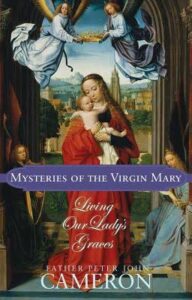 Mysteries of the Virgin Mary approaches the task of increasing understanding of the theology behind Marian doctrine by looking at reasons behind Marian
Mysteries of the Virgin Mary approaches the task of increasing understanding of the theology behind Marian doctrine by looking at reasons behind Marian  feasts throughout the liturgical year. Chapters cover the Birth of Mary, her Presentation, her Immaculate Heart, her Holy Name, and her role as Queen of Heaven, as well as her titles as Our Lady of Sorrows, Our Lady of Guadalupe, and, of course, Our Lady of the Rosary. Read excerpts and learn more about Mysteries of the Virgin Mary and other works related to Bible study at ex libris—main bookshelf.
feasts throughout the liturgical year. Chapters cover the Birth of Mary, her Presentation, her Immaculate Heart, her Holy Name, and her role as Queen of Heaven, as well as her titles as Our Lady of Sorrows, Our Lady of Guadalupe, and, of course, Our Lady of the Rosary. Read excerpts and learn more about Mysteries of the Virgin Mary and other works related to Bible study at ex libris—main bookshelf.
WHAT DO YOU THINK of as your earliest religious memories?
The title of Lesson 1—”Contemplating Christ with Mary”—indicates that the main focus of this introductory lesson is on how these prayers of the Blessed Virgin Mary are connected to proper worship of Jesus Christ. In Rosarium Virginis Mariae (Rosary of the Virgin Mary), Pope St. John Paul II offers an inspirational explanation of why the Rosary holds such a place of honor as a traditional Catholic prayer. Scripture & the Rosary: New Testament Mysteries, Old Testament Parallels looks at key events in the life of Jesus Christ as remembered by his Mother. The first lesson emphasizes that memory is closely tied to worship.
 ? What are your earliest memories related to worship?
? What are your earliest memories related to worship?
? What are your most significant memories of God at work in your life?
? How do you think that these memories might have an impact on your current worship practices?
the popes inspire us—thoughts about contemplation from Pope Francis
In a September 26, 2014, address, Pope Francis urged members of the Focolare Movement to grow  in the spirit of contemplation as one of several guidelines he proposed for them. (Others focus on evangelization and on forming the faithful into a school of humanity.) The Holy Father sees a critical need for contemporary Christians to contemplate God and the wonders of his love. According to the Pope, in order to grow in contemplation it’s necessary to widen one’s heart “to the measure of Jesus and of the gift of his Spirit,” and to make contemplation “the indispensable condition of effective action that is truly free and pure.”
in the spirit of contemplation as one of several guidelines he proposed for them. (Others focus on evangelization and on forming the faithful into a school of humanity.) The Holy Father sees a critical need for contemporary Christians to contemplate God and the wonders of his love. According to the Pope, in order to grow in contemplation it’s necessary to widen one’s heart “to the measure of Jesus and of the gift of his Spirit,” and to make contemplation “the indispensable condition of effective action that is truly free and pure.”
the Rosary is a sacramental
The Rosary is one of the most popular Catholic devotions. You can learn more about this source of spiritual power in “Sacramentals” on page 6 in Scripture & the Rosary: New Testament Mysteries, Old Testament Parallels.
another video—one that could change the way you approach the Bible (40:44)
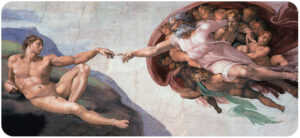 Even if you’re a veteran of Catholic Bible studies, we encourage you to watch an explanation of the practical benefits of approaching The Bible as the Living Word of God. This 40-minute video is distilled from a talk that Turning to God’s Word author Matthew Phelps gave at a summer Bible study retreat at Conception Abbey in Conception, Missouri. In this video, Matthew looks at how viewing Scripture as a living document can help us to develop a more intimate relationship with Jesus Christ. There are benefits in setting aside what we think we know about Scripture to approach the Bible with the goal of learning what new things God is saying to us. Matthew examines the principles of lectio divina, the traditional Catholic approach to reading and praying with Scripture that’s foundational for all Turning to God’s Word Bible studies.
Even if you’re a veteran of Catholic Bible studies, we encourage you to watch an explanation of the practical benefits of approaching The Bible as the Living Word of God. This 40-minute video is distilled from a talk that Turning to God’s Word author Matthew Phelps gave at a summer Bible study retreat at Conception Abbey in Conception, Missouri. In this video, Matthew looks at how viewing Scripture as a living document can help us to develop a more intimate relationship with Jesus Christ. There are benefits in setting aside what we think we know about Scripture to approach the Bible with the goal of learning what new things God is saying to us. Matthew examines the principles of lectio divina, the traditional Catholic approach to reading and praying with Scripture that’s foundational for all Turning to God’s Word Bible studies.
visual meditation is a form of prayer
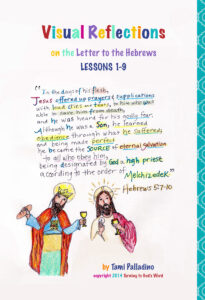 If you like to draw, consider illustrating your prayers for Scripture & the Rosary: New Testament Mysteries, Old Testament Parallels. Check out the visual-meditation journal
If you like to draw, consider illustrating your prayers for Scripture & the Rosary: New Testament Mysteries, Old Testament Parallels. Check out the visual-meditation journal  that Turning to God’s Word co-founder Tami Palladino created for The Letter to the Hebrews: An Explanation of the Mechanism of Our Salvation. Tami also illustrated Sing a New Psalm: Communicating with God Through the Prayers of the Church—Volume I: Lauds & Vespers and The Revelation of Jesus Christ: The Faithful Witness, and some lessons in You Shall Have No Other Gods: The Book of Exodus and In the Beginning: The Book of Genesis.
that Turning to God’s Word co-founder Tami Palladino created for The Letter to the Hebrews: An Explanation of the Mechanism of Our Salvation. Tami also illustrated Sing a New Psalm: Communicating with God Through the Prayers of the Church—Volume I: Lauds & Vespers and The Revelation of Jesus Christ: The Faithful Witness, and some lessons in You Shall Have No Other Gods: The Book of Exodus and In the Beginning: The Book of Genesis.
Q&A—where to find some answers
Some people are used to doing Bible studies from other publishers, and they’ve told us that they miss the answer keys many of those studies offer. One leader even admitted that she relied on answer keys so she didn’t have to spend time doing Bible study lessons herself. We sympathize with omnipresent time constraints, but we maintain that up-front answer keys provide people with a strong temptation to rely on someone else’s idea of what Scripture means instead of thinking more deeply about what God might be trying to say to each of us as individuals at a particular moment in time.
 Q: Why don’t Turning to God’s Word Catholic Bible studies provide any printed answer keys?
Q: Why don’t Turning to God’s Word Catholic Bible studies provide any printed answer keys?
A: The Turning to God’s Word method of Bible study is dependent on participants directly engaging with the biblical text and looking to that text for answers to their questions. All of the factual questions in the lessons can be answered from the Scriptures. Sidebars in the lessons contain supplemental material written to help explain some of the themes suggested by the biblical text. Most of our studies, including this one, feature videos with each lesson.
Outside commentaries can shed light on individual texts, but many commentaries examine Scripture passages out of context. Some may focus on an academic rather than a spiritual approach to the Bible. If you’re confused about anything in our studies or in any related outside commentaries, we encourage you to browse our website for more information.
The goal of all Turning to God’s Word Catholic Bible studies is to foster personal reflection leading to a more intimate relationship with Jesus. Consequently, each lesson contains  reflection questions, and these necessarily don’t have any “right” or “wrong” answers. If you’d like to share your thoughts about any of our studies or need clarification about a question, commentary, or video related to the lessons, contact us using the “ask us your question” or “what do you think” button on any online lesson page. Because others may have the same concern, we routinely turn questions and comments we receive into anonymous Q&A items and add them to the relevant online study pages.
reflection questions, and these necessarily don’t have any “right” or “wrong” answers. If you’d like to share your thoughts about any of our studies or need clarification about a question, commentary, or video related to the lessons, contact us using the “ask us your question” or “what do you think” button on any online lesson page. Because others may have the same concern, we routinely turn questions and comments we receive into anonymous Q&A items and add them to the relevant online study pages.
Q&A—three questions about Bible translations
We’re frequently asked what translation of the Bible is best. Sometimes we’re asked which translation is approved to be read at Catholic Masses. More infrequently we’re asked why we’ve chosen to reprint the Revised Standard Version Second Catholic Edition (RSV2CE) for the biblical text in our printed studies.
Q1: Which translation of the Bible is the best one for Catholics to read? 
A2: As far as which translation is best, we maintain that reading any translation of the Bible you have on hand is a great place to start. The old adage “every translator is a traitor” certainly applies to Scripture, but God’s basic message to his people can be found in any Bible. While there are English-language Bibles catering to a variety of special-interest Catholic groups, they generally reprint either a translation of the New American Bible Revised Edition (the NABRE) or a Catholic edition of the Revised Standard Version (the RSVCE or the RSV2CE), which are the Bibles read by most American Catholics. Both of these translations rely on archeological finds and scholarship that were unavailable in earlier centuries. Prior to the mid-1960s, many Catholics were familiar with the Douay-Rheims English translation, which was based on the Latin Vulgate. Originally translated by St. Jerome in the late 4th century, a version of the Vulgate has remained the official Latin translation of the Catholic Church since the 16th century. Prior to the mid-1960s, most Protestants read The King James Version.
As people become more interested in Scripture study, they also become more interested in reading the “right” Bible. Since very few of us are proficient in ancient languages, we’re forced to rely on the work of scholars who’ve spent years studying Hebrew, Greek, Aramaic, and Latin. In many cases, there simply isn’t an easy way to translate some of the original words and phrases of Scripture into English. The best advice we can offer is to choose an English translation that the Church has approved. The United States Conference of Catholic  Bishops (USCCB) offers guidelines. When questions arise, as they undoubtedly will, check out footnotes, commentaries, and other translations; talk to a knowledgeable priest; and—this part is most important—ask God to grant you increased understanding. You also can email us with your questions about Scripture. In many cases, Turning to God’s Word author Matthew Phelps’ background in classical languages proves helpful. We frequently rely on him to shed some light on the linguistics involved in difficult passages.
Bishops (USCCB) offers guidelines. When questions arise, as they undoubtedly will, check out footnotes, commentaries, and other translations; talk to a knowledgeable priest; and—this part is most important—ask God to grant you increased understanding. You also can email us with your questions about Scripture. In many cases, Turning to God’s Word author Matthew Phelps’ background in classical languages proves helpful. We frequently rely on him to shed some light on the linguistics involved in difficult passages.
Q2: I’m having trouble locating the same Bible that I hear read at Mass. What translation is that?
A2: The Catholic Lectionary, a collection of biblical texts approved for liturgical use, isn’t the same as a Bible. The English-language lectionary used in the United States is primarily based on a 1970 translation. A close English translation outside the lectionary is the New American Bible Revised Edition (NABRE). The United States Conference of Catholic Bishops (USCCB) currently is working on a liturgical Bible based on the NABRE translation.
 Q3: Why has Turning to God’s Word chosen to reprint biblical text from the Revised Standard Version Second Catholic Edition (RSV2CE) instead of the New American Bible Revised Edition (NABRE)?
Q3: Why has Turning to God’s Word chosen to reprint biblical text from the Revised Standard Version Second Catholic Edition (RSV2CE) instead of the New American Bible Revised Edition (NABRE)?
A3: We currently use the Revised Standard Version Second Catholic Edition (RSV2CE) as our primary biblical translation in our printed studies because scholars consider it to be a more faithful word-for-word translation than many other translations. Pope Benedict XVI quotes from the RSV2CE in his three-volume book, Jesus of Nazareth. The RSVCE is the Bible translation used in English translations of the Catechism of the Catholic Church. The RSV2CE varies only slightly from the earlier RSVCE, which we link to on our online study pages. Any discrepancies between the RSV2CE and the RSVCE are pointed out on the online study pages. Turning to God’s Word cites The Abbey Psalms and Canticles in references to the Psalms in all of our printed studies.
pray with the Psalms—intensely emotional prayers
Although some scholars question David’s authorship of the Psalms, it remains indisputable that many of the Psalms address  themes related to events that occurred during the period when David ruled all of the descendants of Jacob. Reading and praying with the Psalms offers insight into the minds and hearts of people who lived during the time of David and who lived long afterward as well. These prayers express universal human feelings every bit as relevant to us in the present day as when the Psalms first were composed.
themes related to events that occurred during the period when David ruled all of the descendants of Jacob. Reading and praying with the Psalms offers insight into the minds and hearts of people who lived during the time of David and who lived long afterward as well. These prayers express universal human feelings every bit as relevant to us in the present day as when the Psalms first were composed.
don’t get confused—Psalms numbering varies
Numbering of many Psalms and their verses varies from one translation to another. Parallel  numbering for commonly used Catholic Bibles is noted in the citations index located at the back of all sets of lessons in Scripture & the Rosary: New Testament Mysteries, Old Testament Parallels. To learn why the numbering varies, see the Q&A on the online study page for Lesson 1 Set a Guard on My Mouth in the Turning to God’s Word Catholic Bible study Sing a New Psalm: Communicating with God Through the Prayers of the Church—Volume I: Lauds & Vespers.
numbering for commonly used Catholic Bibles is noted in the citations index located at the back of all sets of lessons in Scripture & the Rosary: New Testament Mysteries, Old Testament Parallels. To learn why the numbering varies, see the Q&A on the online study page for Lesson 1 Set a Guard on My Mouth in the Turning to God’s Word Catholic Bible study Sing a New Psalm: Communicating with God Through the Prayers of the Church—Volume I: Lauds & Vespers.
don’t forget about our indexes & extra online material

 If you’re trying to locate information about a Scripture passage, you can look it up in the index at the back of the online version of this study. If you want to revisit a commentary, you can look it up by title in the topics index. If you want to learn more about another book of the Bible for which there’s a Turning to God’s Word study, you can read online commentaries and watch any accompanying videos by choosing a lesson from one of the study directories. (There are no lesson videos with Scripture & the Rosary: New Testament Mysteries, Old Testament Parallels.) Finally, if you have a question or would like to make a comment about any of our studies, you can use the “ask us your question” or “what do you think” button to email our authors.
If you’re trying to locate information about a Scripture passage, you can look it up in the index at the back of the online version of this study. If you want to revisit a commentary, you can look it up by title in the topics index. If you want to learn more about another book of the Bible for which there’s a Turning to God’s Word study, you can read online commentaries and watch any accompanying videos by choosing a lesson from one of the study directories. (There are no lesson videos with Scripture & the Rosary: New Testament Mysteries, Old Testament Parallels.) Finally, if you have a question or would like to make a comment about any of our studies, you can use the “ask us your question” or “what do you think” button to email our authors.
ex libris—Church documents & books about religious topics
Link to magisterial documents referred to in our Bible studies at ex libris—magisterial documents.  This listing includes significant recent encyclicals as well as a number of historical Church documents. Recommended books related to Scripture study can be found at ex libris—main bookshelf.
This listing includes significant recent encyclicals as well as a number of historical Church documents. Recommended books related to Scripture study can be found at ex libris—main bookshelf.
pray the Rosary
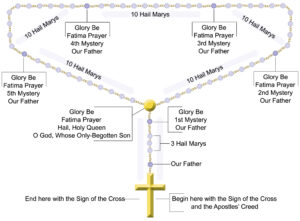 We invite you to pray the Rosary along with Turning to God’s
We invite you to pray the Rosary along with Turning to God’s  Word co-founder Tami Palladino and her daughter Anne Marie. Their videos are available on the online study pages for Lessons 7 through 26, and the Rosary prayers as well as the videos for all 20 mysteries are accessible year-round at how to pray the Rosary. Clicking on the diagram (right) will take you to the website page with the Rosary prayers. Watch Tami and Anne Marie’s how-to video (below) to learn more about praying the Rosary.
Word co-founder Tami Palladino and her daughter Anne Marie. Their videos are available on the online study pages for Lessons 7 through 26, and the Rosary prayers as well as the videos for all 20 mysteries are accessible year-round at how to pray the Rosary. Clicking on the diagram (right) will take you to the website page with the Rosary prayers. Watch Tami and Anne Marie’s how-to video (below) to learn more about praying the Rosary.
Lesson 2 The Rosary: A Compendium of the Gospel—Rosarium Virginis Mariae (chapter 2)
you also may like our study of the Gospel According to John
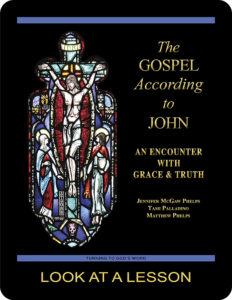 The Gospel According to John: An Encounter with Grace & Truth, a 25-lesson Catholic Bible study with an imprimatur, examines the Fourth Gospel’s view of Jesus Christ as the Son of God, with special emphasis on the institution of the sacraments of the Church as the means by which Christians are purified and made holy. This recently revised study includes maps and additional commentary, and takes a closer look at the way in which Jesus relates to individual men and women. Click on the book’s cover to view a sample lesson.
The Gospel According to John: An Encounter with Grace & Truth, a 25-lesson Catholic Bible study with an imprimatur, examines the Fourth Gospel’s view of Jesus Christ as the Son of God, with special emphasis on the institution of the sacraments of the Church as the means by which Christians are purified and made holy. This recently revised study includes maps and additional commentary, and takes a closer look at the way in which Jesus relates to individual men and women. Click on the book’s cover to view a sample lesson.
start a Turning to God’s Word Bible study
Thank you for your interest in Scripture & the Rosary: New Testament Mysteries, Old Testament Parallels. 
 Information about beginning a Turning to God’s Word Bible study can be found at start a Bible study. Tami, Matthew, and I are available to answer your questions and to offer support. You may use this email to contact us directly if you’re interested in starting a Turning to God study or in having your study schedule listed with other TtGW study groups on our website. —Jennifer
Information about beginning a Turning to God’s Word Bible study can be found at start a Bible study. Tami, Matthew, and I are available to answer your questions and to offer support. You may use this email to contact us directly if you’re interested in starting a Turning to God study or in having your study schedule listed with other TtGW study groups on our website. —Jennifer
*There are seven deuterocanonical books in the Old Testament—the Books of Tobit, Judith, Wisdom, Sirach, Baruch, and First and Second Maccabees, as well as some passages in the Books of Esther and Daniel. Protestants usually refer to these works as “apocryphal,” a word that means “outside the (Protestant) canon” because they’re excluded from most Protestant Bibles. The word “deuterocanonical” means “second canon”; Catholics use that word to refer to any section of the Catholic Old Testament for which there are no extant, or existing, Hebrew manuscripts. All of the deuterocanonical books appear in the Septuagint, the earliest remaining versions of which date to the 1st century B.C. This Greek translation of the Old Testament was in common use by Jews at the time of Jesus. Learn more by reading How Do Catholic & Protestant Bibles Differ?
Turning to God’s Word printed Bible studies use the 2006 Revised Standard Version Second Catholic Edition (RSV2CE) translation for all Scripture references except those to the Psalms, which are taken from The Abbey Psalms and Canticles, prepared by the Benedictine monks of Conception Abbey and published in 2020 by the United States Conference of Catholic Bishops (USCCB). All Scripture links for the digital version of Scripture & the Rosary: New Testament Mysteries, Old Testament Parallels are to the 1966 Revised Standard Version Catholic Edition (RSVCE) translation. The New International Version (NIV) audio recordings follow the same chapter and verse numbering as the RSV Catholic translations, but the NIV translation doesn’t include the deuterocanonical books and passages.
The 1966 RSVCE uses archaic pronouns and verb forms such as “thee,” “thou,” “didst” in the Psalms and in direct quotations attributed to God. The 2006 RSV2CE replaces these with more accessible English. The few significant translation changes in the RSV2CE include rendering almah as “virgin” in the Book of Isaiah 7:14 and restoring the term “begotten” in the Gospel According to John 3:16.
Numbering varies for some passages in this Bible study. Turning to God’s Word studies follow the numbering in the Revised Standard Version Catholic translations (RSV2CE and RSVCE). Discrepancies in the New American Bible Revised Edition (NABRE) are noted in the Index of Scripture Citations.
 You can learn more about the Psalms by viewing a sample lesson from the Turning to God’s Word Catholic Bible study Sing a New Psalm: Communicating with God Through the Prayers of the Church—Volume I: Lauds & Vespers. The second part of that study, Sing a New Psalm: Communicating with God Through the Prayers of the Church—Volume II: Vigils, Day Prayer & Compline, is scheduled for publication in 2025. Some verse numbers may vary in different translations of the Psalms.
You can learn more about the Psalms by viewing a sample lesson from the Turning to God’s Word Catholic Bible study Sing a New Psalm: Communicating with God Through the Prayers of the Church—Volume I: Lauds & Vespers. The second part of that study, Sing a New Psalm: Communicating with God Through the Prayers of the Church—Volume II: Vigils, Day Prayer & Compline, is scheduled for publication in 2025. Some verse numbers may vary in different translations of the Psalms.
